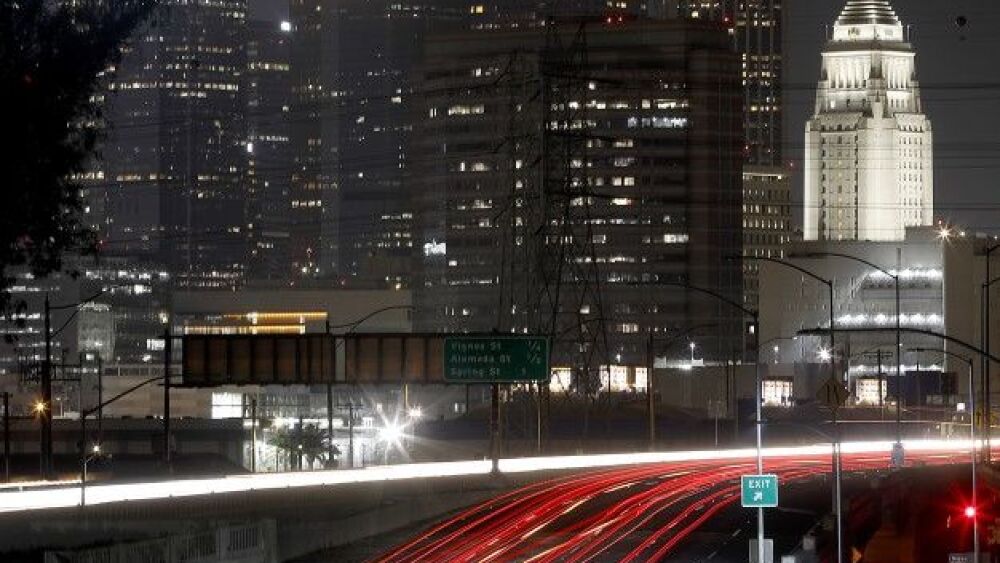Richard Winton, Laura J. Nelson and Cindy Chang
Los Angeles Times
LOS ANGELES — With millions of Southern Californians hunkering down at home, traffic has been blissfully light — a rare positive in a time of sickness, death, unemployment and isolation.
But in the age of coronavirus, people still venture out to the supermarket or to help elderly relatives. And some are succumbing to the temptations of wide-open roads.
Speeds are up by as much as 30% on some Los Angeles streets, according to a preliminary analysis by the city’s Department of Transportation that measured traffic at a subset of locations.
Since stay-at-home orders from the city, county and state took effect in mid-March, drivers overall were going about 12% faster on weekdays and 6% faster on weekends, the analysis found.
The increase in speeds on the eerily empty streets is “troubling,” said Los Angeles Police Chief Michel Moore, who is working with city transportation officials on solutions, including adjusting traffic signals and stationing police officers on problem stretches.
The pedal-to-the-metal driving comes at the same time that stir-crazy residents are walking and cycling more, sometimes crisscrossing streets multiple times to avoid passing close to one another.
Moore cited a recent high-speed crash on Highland Avenue that claimed two lives.
“What I would ask and implore upon the public is that they slow down, is that they respect the rules of the road, that they recognize that the pedestrian traffic has increased, that there are many more walkers and cyclists that are there today,” Moore said at a Police Commission meeting conducted remotely last week.
To make speeding more difficult, transportation officials are leaving a majority of the city’s 5,000 traffic lights on nighttime settings.
In the daytime, green lights are normally synchronized so drivers can get through a series of intersections without stopping, in a so-called green wave.
But when streets are empty, that synchronicity creates perfect conditions for speeding, especially when drivers race through yellow lights, said Seleta Reynolds, Department of Transportation general manager.
On nighttime settings, each light cycles individually through red, yellow and green.
If “you manage to get ahead of the green wave, you can go really fast along every corridor,” Reynolds said.
To aid pedestrians, the city has automated more than 400 walk signals in Westlake, Chinatown, downtown, Hollywood and Koreatown so people do not have to risk contagion by pushing the button. Similar changes are being considered for other neighborhoods with many pedestrians, including those with medical buildings.
Speeds are also up on California highways, particularly those stretches usually backed up with commuters.
On the notoriously clogged 405 Freeway near the Getty Center, average speeds were up by nearly 7 mph since the stay-at-home orders, according to a study by Fraser Shilling and David Waetjen of UC Davis.
But peak speeds, defined as the 95th percentile of all drivers, only increased by 3 mph.
On Interstate 5 near the 14 Freeway interchange, average speeds were up by more than 9 mph, while peak speeds were unchanged.
The study also documented a massive decrease in traffic volume on California highways and a 50% decrease in collisions.
Drivers are now able to go at a normal pace rather than a rush-hour crawl and for the most part are not ratcheting up to extreme speeds, said Shilling, co-director of UC Davis’ Road Ecology Center, who updated the study this week to include the speed data.
“The open roads are not leading to people going 90 [mph] instead of 65 to 70,” he said.
However, a few people are taking advantage of the broad expanses to drive dangerously fast. The Highway Patrol has been writing more citations for speeds in excess of 100 mph, even with many fewer cars on the highways and a drop in overall citations.
Between March 19 and March 29, CHP officers wrote 543 tickets for such extreme speeds, compared with 418 last year.
In the San Fernando Valley, Capt. Andy Neiman of the LAPD’s Traffic Group said his officers are encountering motorists in a huge hurry, which endangers lives at a time when emergency medical resources are stretched thin by the coronavirus outbreak.
Amid an all-out push by the LAPD to put more officers on patrol, Neiman said that his traffic contingent remains nearly at full strength.
“A lot of people out there think there is a license to drive faster because of the coronavirus situation,” Neiman said. “Lives are being threatened by these drivers. While we are all worried about the virus, they are going to kill someone.”
With fewer cars on the road, the number of collisions was down in L.A., from 2,195 in the first two weeks of March to 896 in the two weeks after the stay-at-home orders, according to the LAPD.
The percentage of accidents classified as “severe” increased slightly, to 3% from 2%, though the absolute number was down, with 29 severe collisions compared with 54 a year ago.
Even with these declines, officials are anxious to clamp down on speeding, which was the primary factor in 17% of the severe collisions since March 15.
At a daily coronavirus news briefing last week, Mayor Eric Garcetti urged Angelenos to slow down.
“Just because there isn’t traffic, that’s not an excuse to break the speed limit,” he said.












